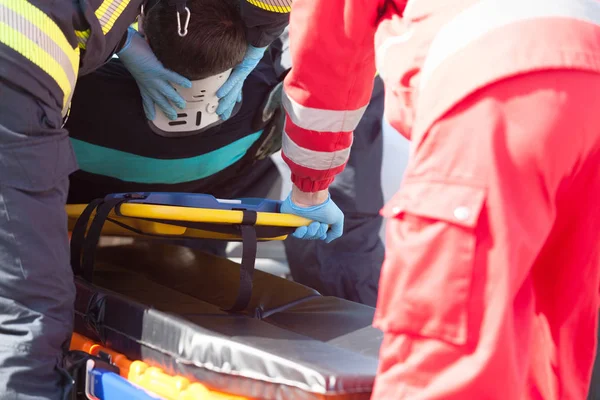What Does Injuries Incompatible with Life Mean? A Comprehensive Explanation
“Injuries incompatible with life” is a medical term used to describe severe and catastrophic injuries or medical conditions that are so extensive and irreversible that they cannot be effectively treated or overcome, ultimately leading to the loss of life.
These injuries are typically characterized by extensive damage to vital organs, major blood vessels, or the brain, making survival impossible. Healthcare professionals, including doctors and paramedics, may use this term when they encounter injuries that leave no reasonable chance of recovery.
It is a difficult but crucial concept in healthcare, guiding decisions regarding the allocation of medical resources and end-of-life care, as well as providing clarity to patients and their families when facing devastating situations.
What Are The Types and Characteristics of Injuries Incompatible with Life?

In the realm of medicine, injuries incompatible with life encompass a range of traumatic and non-traumatic conditions.
Trauma-Related Injuries
Severe Head Trauma: Injuries to the head that result in extensive brain damage are often incompatible with life. This can include major brain hemorrhages, traumatic brain injuries, or other traumatic events that significantly impair brain function. The brain is the command center for the body’s vital functions, and severe damage can disrupt critical processes like breathing and consciousness.
High-Impact Crashes: In situations involving high-impact crashes, such as car accidents at high speeds or falls from significant heights, the combination of multiple severe injuries can render the overall condition incompatible with life. These injuries may involve extensive internal damage, fractures, and severe internal bleeding, collectively overwhelming the body’s ability to maintain essential functions.
Devastating Organ Damage: Injuries that lead to extensive damage to vital organs, such as the heart, lungs, or liver, are also classified as incompatible with life. These organs are fundamental for sustaining life, and severe damage hampers their ability to perform their functions. As a result, the body cannot maintain its crucial processes.
Non-Traumatic Conditions
Late-Stage Terminal Illness: In some instances, non-traumatic conditions like late-stage cancer, advanced organ failure, or untreatable infections may be labeled as incompatible with life when curative treatments are no longer viable. In these cases, the progression of the disease or condition has reached a stage where it significantly compromises the patient’s ability to continue living.
Severe Neurological Disorders: Certain neurological disorders can lead to a complete loss of brain function. Conditions like advanced neurodegenerative diseases, which result in profound cognitive and physical impairment, may be classified as incompatible with life because there is no longer a meaningful existence or quality of life.
Overwhelming Blood Loss: Profuse and uncontrollable bleeding, whether due to trauma or underlying medical conditions, can rapidly lead to a state that is incompatible with sustaining life. Loss of a critical volume of blood affects the body’s ability to supply vital organs with oxygen and nutrients, ultimately leading to organ failure.
How Are Injuries Incompatible with Life Diagnosed and Assessed?
Diagnosing and assessing injuries incompatible with life is a crucial aspect of medical practice, particularly in situations where patients have sustained severe trauma or have medical conditions with minimal chances of survival. Accurate and timely diagnosis helps medical professionals make informed decisions about treatment and care.
Medical Evaluation and Criteria:
Extensive Trauma Assessment: When a patient with severe injuries arrives in an emergency room, a thorough trauma assessment is initiated. Medical professionals evaluate vital signs, physical examinations, and medical history to understand the extent of trauma. They look for signs of critical injuries that may be incompatible with life, such as unresponsiveness, severe bleeding, or catastrophic injuries to vital organs.
Incompatibility Criteria: Healthcare organizations and institutions often establish specific criteria that guide the determination of injuries incompatible with life. These criteria typically include factors such as the extent of organ damage, the presence of severe brain injuries, or the magnitude of blood loss. Meeting these criteria is a crucial step in reaching a diagnosis.
Radiological and Imaging Studies: Medical imaging, particularly computed tomography (CT) scans and magnetic resonance imaging (MRI), plays a pivotal role in assessing injuries. These advanced imaging studies provide detailed visualizations of injuries, aiding healthcare professionals in determining the severity of trauma. For example, CT scans are particularly useful in assessing head injuries and internal organ damage.
Imaging and Diagnostic Tools
CT Scans and MRI: CT scans and MRIs are instrumental in diagnosing and assessing injuries incompatible with life. They allow healthcare professionals to visualize injuries in great detail, offering insights into the extent of damage. For example, in cases of severe head trauma, these imaging tools provide critical information about brain injuries and their impact on vital functions.
Ultrasound: Ultrasound is valuable in assessing various conditions that may lead to injuries incompatible with life. It is particularly useful for evaluating internal bleeding, damage to vital organs, and issues affecting fetal development during pregnancy.
Laboratory Tests: Blood tests are essential for evaluating patients with severe injuries. These tests can provide valuable information about a patient’s physiological condition. Parameters like hemoglobin levels, blood gas values, and markers of organ function are measured to assess the extent of trauma and the overall health of the patient.
Collaborative Decision-Making: Determining injuries incompatible with life often involves the collaboration of multidisciplinary healthcare teams. Trauma surgeons, radiologists, critical care physicians, and other specialists work together to ensure a thorough and well-informed assessment. Collaborative decision-making is critical in complex cases, as it helps medical professionals reach a consensus on the diagnosis.
What Are the Ethical Considerations in Providing End-of-Life Care?
Firstly, healthcare professionals face an ethical dilemma when dealing with injuries incompatible with life. An essential ethical principle is open and honest communication with patients and their families. Providing accurate information while showing empathy and support is crucial.
Moreover, the ethical framework often includes shared decision-making. Patients and their families should be actively involved in determining their care plan, taking into account their values and preferences.
However, palliative care is a fundamental aspect of end-of-life care for patients with injuries incompatible with life. This specialized care focuses on symptom management, pain relief, and enhancing the patient’s comfort and quality of life during their remaining time.
Ethical considerations also encompass ensuring a dignified end-of-life experience for the patient. This includes maintaining the patient’s autonomy, respecting their wishes, and providing emotional and psychological support to both the patient and their family.
Futhermore, providing support for the patient’s family and caregivers is a vital ethical consideration. The emotional and psychological burden they carry is significant, and they require resources and assistance to cope with the situation.
What Are the Psychological Effects of Injuries Incompatible with Life?

Injuries incompatible with life bring about profound psychological effects on patients and their families, which can be emotionally overwhelming. These injuries, often resulting from severe trauma or terminal medical conditions, lead to a range of emotional responses, including fear, anxiety, sadness, and a sense of hopelessness.
The patients may also face anticipatory grief as they mourn the life they had envisioned and grapple with a deep sense of loss. Existential questions about the meaning and purpose of life may arise.
Post-traumatic stress, with symptoms like flashbacks and nightmares, can be a result in cases of traumatic injuries. The psychological impact extends to families and caregivers who experience stress and emotional exhaustion, sometimes leading to caregiver burnout. Effective communication about end-of-life decisions and advance directives can be challenging, adding to the psychological stress.
Coping mechanisms vary, from turning to support groups and therapy to unhealthy options like substance abuse or denial. The healthcare providers themselves are not immune to these psychological effects; they may experience moral distress and emotional exhaustion as they care for patients in these difficult situations.
Despite these challenges, some individuals and families show remarkable resilience, finding ways to create meaningful moments and find peace in their final days together. Understanding the psychological impact is crucial for providing comprehensive care, and offering psychological support, counseling, and therapies can help individuals and their families cope with the emotional and existential challenges they face in these situations.
FAQ
What is the most serious injury ever?
The most serious injury ever can be debated, but some of the most severe injuries include traumatic brain injuries, severe spinal cord injuries, and extensive organ damage. These can be life-altering and sometimes fatal.
What are the rarest injuries?
Rare injuries can include bizarre accidents like getting struck by lightning or being injured by a falling meteorite. These injuries are exceptionally uncommon and often attract significant attention.
What injury causes the most deaths?
Globally, road traffic accidents are one of the leading causes of injury-related deaths. Other significant causes include falls, drowning, and firearms-related injuries.
What is the most painful injury in the world?
Pain is subjective, but some injuries are notorious for their intense pain. Compound fractures, kidney stones, and burns are among the most excruciating injuries people can experience.
Who killed the most humans in history?
Regrettably, human history has seen many individuals and groups responsible for significant loss of life. Figures like Adolf Hitler and Joseph Stalin, responsible for millions of deaths, are among the deadliest in history.
What is the most popular injury?
Common injuries include sprains, strains, and minor cuts and bruises. These injuries often result from everyday activities and accidents.
What is the hardest injury to heal?
Injuries to the spinal cord and brain can be the most challenging to heal due to the complexity of neural tissues. Complete recovery from such injuries is often rare.
What is the most minor injury?
Minor injuries can include small cuts, bruises, and mild burns. While they may be painful, they typically heal on their own with minimal intervention.
What are the easiest injuries to get?
Easiest injuries to get are often minor cuts and scrapes, which can happen during routine activities. Sprains and strains can also occur with sudden, awkward movements.
What is the hardest injury to diagnose?
Injuries involving soft tissues like ligaments or tendons can be challenging to diagnose since they may not show up on standard X-rays. MRI and specialized tests are often required for accurate diagnosis.
Why do injuries not hurt at first?
Sometimes, the body’s response to injury may not cause immediate pain. This can be due to shock or the release of adrenaline, which temporarily masks the pain. Pain may become more noticeable as the body’s response wanes.
Final words
On the whole, “Injuries Incompatible with Life” refer to severe injuries or medical conditions that are so critical that medical treatment offers little to no hope of recovery. This term is a stark reminder of the fragility of life and the limits of medical intervention.
It involves respecting the patient’s autonomy, providing comfort, and ensuring that their values and preferences are honored. It’s a challenging and emotional journey for patients, their families, and healthcare providers. While these situations are incredibly difficult, they also underscore the importance of compassionate end-of-life care, respecting cultural and spiritual beliefs, and making choices that prioritize the patient’s well-being and comfort.
It’s a sensitive topic that reminds us of the significance of life and the importance of making the best decisions when faced with the inevitable.







